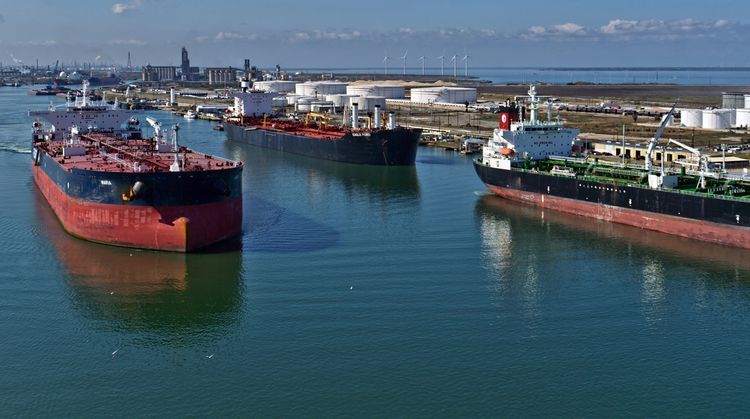
Late last month, an oil tanker that measures three football fields long and six stories high moved slowly through the port of Corpus Christi, Texas, to test the waters of America’s booming crude-export industry.
After navigating the Aransas pass around 7 a.m. on May 26, the vessel, Euronav NV’s Anne, didn’t pick up any oil. But its arrival in the humid air of south Texas marked the first time ever a tanker of that size had called on a U.S. terminal in the Gulf of Mexico.
The Anne docked at Occidental Petroleum Corp.’s terminal to determine if some of the world’s biggest carriers could start ferrying oil from Texas to foreign buyers. The shipping upgrade is necessary after a surge in production from U.S. shale fields like the Permian Basin led to more oil than Gulf Coast refiners could handle. And Corpus Christi is vying to become America’s main export hub.
“Corpus Christi was the No. 1 port for U.S. crude exports last year, and this trend is continuing,” said John LaRue, the port’s executive director.
Shipping oil overseas is something new in the U.S., a country that spent most of the past century refining almost every drop of domestic output. For decades, tankers laden with crude from around the world arrived at Gulf Coast refineries to be made into fuel for American cars and trucks. Dependence on imports grew as domestic output fell.
But in recent years, low-cost drilling methods unlocked vast deposits in places like West Texas. U.S. production has almost doubled and may reach 10 million barrels a day next year for the first time since 1970, government data show.
While the U.S. still consumes more than it produces, supplies from the new Permian and Eagle Ford fields are primarily light, low-sulfur oil. Many of the refineries along the Gulf Coast are designed to process heavy, high-sulfur crude, so it’s more economical to ship the new Texas oil abroad. As a result, America now exports more than OPEC members Qatar, Libya, Ecuador and Gabon.
For analysis of shale’s impact on OPEC and oil markets, click here.
U.S. shipments surpassed 1 million barrels a day in February, a little more than a year after Congress lifted a longtime ban on most foreign sales. Exports could double by the end of this decade, expanding the importance of Corpus Christi to the domestic industry.
To keep the exports flowing, domestic crude will need to remain a cheaper alternative to supplies from traditional producers in the North Sea, West Africa and elsewhere. West Texas Intermediate, the U.S. benchmark pumped from the Permian Basin, has dropped 19 percent this year, trading at $43.52 a barrel as of 12:01 a.m. in New York Tuesday. On average, it’s been 87 cents a barrel less this year than the standard grade used in Asia, compared with a $2.43 premium in 2016.
Corpus Christi is betting the boom will last. The port, where three major pipelines unload crude shipped from southern Texas and from fields hundreds of miles away in the far western reaches of the state, has received preliminary approval from Congress for a $350 million dredging project that would deepen its channel to 52 feet (16 meters) from 45 feet. That would allow more million-barrel supertankers to load.
“This area has advantages as an export hub since it’s less congested” than the shipping channel in Houston, the other major Gulf port about 200 miles (321 kilometers) away, Andrew Shepard, a refining and oil-product markets analyst at Wood Mackenzie Ltd., said by telephone from Houston.
Export Hub
Last quarter, ships carrying about 22 million barrels destined for foreign countries left Corpus, government data show. That was almost 30 percent of the country’s total exports.
Daily export capacity could grow to 2.8 million barrels from 960,000 now, according to port officials. Houston, the second-biggest crude exporting hub, can ship 1.7 million barrels a day, said New York-based Timm Schneider, senior managing director for financial consultant Evercore ISI.
Right now, most of the ships handling crude in the port are Aframax carriers that hold about 600,000 barrels of crude. Once the dredging project is complete, Corpus Christi would be able to handle Suezmax tankers that load about 1 million barrels. The VLCCs like Anne hold as much as 2 million barrels, so they remain too big for the channel.
But producers are looking toward a day when the port can handle those big tankers, too.
“The Permian Basin is the largest basin producing crude in the United States,” Cynthia Walker, Occidental’s senior vice president of marketing and midstream operations, said last month at the company’s terminal in Ingleside, Texas, on the northern end of Corpus Cristi Bay. “It’s the fastest growing in the world.”
The Anne alone could hold 11 days of the company’s daily production in the Permian, which was 185,000 barrels of oil a day at the end of 2016, she said.
Two more pipelines, the EPIC and South Texas Gateway, are slated to open in 2019, bringing more oil to the coast. Several companies have expressed interest in adding storage capacity at the port, LaRue said.
Occidental, Buckeye Partners LP, NuStar Energy LP and Magellan Midstream Partners LP, which operate terminals in the port, are interested in the dredging project to deepen the channel, he said.
The dredging expansion — 60 percent of which would be funded by the U.S. government — has to win final approval from lawmakers.
“It was a positive sign that both committees gave their initial approvals for the project so quickly,” during meetings in late April in Washington, D.C., LaRue said. “If there is an infrastructure bill and if we are in the infrastructure bill in some fashion, it could be funded quick. It could be done in three years.”
Recommended for you
